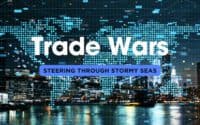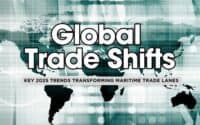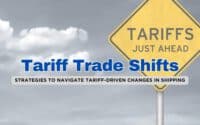Winning Strategies for Promoting Free Trade in a World of Growing Tariffs
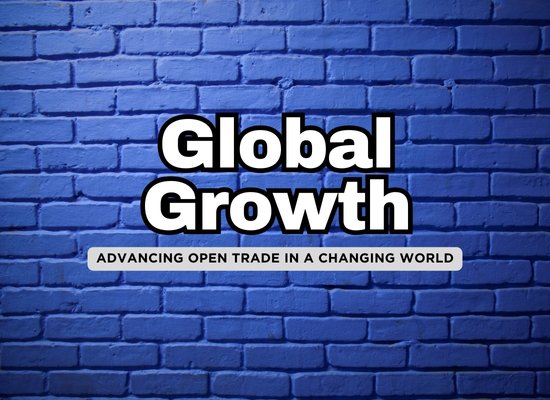
In today’s global shipping industry, trade policies are shifting faster than ever. With tariffs on the rise, shipowners, logistics managers, and exporters find themselves navigating costly obstacles that hinder smooth trade operations. While tariffs are sometimes implemented to protect domestic industries, they can also create unintended disruptions in global supply chains. Open trade agreements—where barriers such as tariffs, quotas, and import restrictions are minimized—have consistently proven to be a driving force behind economic growth, lower shipping costs, and greater market access. For those in the maritime industry, advocating for and maintaining open trade is not just an ideal—it’s a necessity.
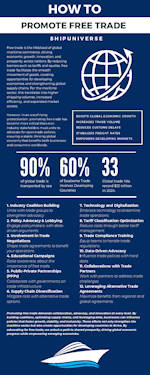
12 Strategies for Promoting Free Trade Infographic
Unlock global growth by advocating for open trade policies, optimizing supply chains, and fostering collaboration. These strategies empower businesses, strengthen economies, and create opportunities worldwide.

** We welcome your feedback, suggestions, corrections, and ideas for enhancements. Please email editor at shipuniverse.com **
| ShipUniverse: Open Trade Benefits (Summary) | |
| Benefit | Description |
| Boosts Global Prosperity | Open trade encourages global economic cooperation, driving higher living standards by making essential goods and technologies more accessible and affordable. This reduces poverty, fosters development, and strengthens global partnerships. |
| Increases Trade Volume and Economic Growth | Removing trade barriers allows countries to export and import goods more freely. This creates more business opportunities, increases investment, and stimulates innovation, which drives long-term economic growth across regions. |
| Creates Jobs and Supports Local Economies | Expanding trade fosters job creation, particularly in manufacturing, agriculture, logistics, and port operations. As trade increases, both direct and indirect employment opportunities grow, boosting local economies worldwide. |
| Improves Supply Chain Efficiency | Trade agreements often include measures that streamline customs procedures and reduce bureaucratic delays. This improves the speed and reliability of global supply chains, benefiting businesses and consumers alike by reducing costs and delivery times. |
| Encourages Collaboration and Stability | Open trade strengthens diplomatic ties and promotes peace by encouraging countries to collaborate on economic goals. Stronger trade relationships lead to more stable political and economic environments, reducing global conflict risks. |
1️⃣ Industry Coalition Building 🤝
In a world where trade policies are increasingly complex, no single company can influence global decisions alone. Coalitions amplify the voices of their members, helping industries advocate for free trade policies that drive business growth and stability. Working together enables stakeholders to challenge harmful regulations, lobby for beneficial agreements, and protect their long-term interests.
How to Build Influence Through Coalitions
Here are actionable strategies for effectively engaging with industry coalitions:
- Join Well-Established Trade Associations
- Start by aligning with prominent, active organizations that advocate for free trade. These groups often provide policy analysis, connections to policymakers, and coordinated lobbying efforts. Examples include:
- International Chamber of Shipping (ICS) – Focused on global shipping policy and trade agreements.
- World Shipping Council (WSC) – Represents major container shipping lines and works to reduce trade barriers.
- Baltic and International Maritime Council (BIMCO) – Engaged in trade, customs, and regulatory frameworks across the shipping industry.
- Start by aligning with prominent, active organizations that advocate for free trade. These groups often provide policy analysis, connections to policymakers, and coordinated lobbying efforts. Examples include:
- Collaborate With Regional Industry Groups
- In addition to global players, join regional coalitions that address local trade challenges. For example, the European Community Shipowners’ Associations (ECSA) focuses on trade issues within the EU, while Asian Shipowners’ Association (ASA) targets Asian trade corridors.
- Work With Exporters and Importers
- Strengthen your coalition by partnering with exporters, importers, and logistics companies. This allows you to present a unified argument for policies that benefit all stakeholders in the supply chain.
- Participate in Joint Advocacy Efforts
- Coalitions often organize lobbying visits, publish reports, and coordinate responses to proposed legislation. Get involved by contributing data or case studies that highlight the real-world impact of tariffs on your business.
- Educate Policymakers and the Public
- Collaborate with your coalition to create awareness campaigns that emphasize the benefits of free trade, such as economic growth, job creation, and supply chain stability. Publishing white papers and hosting events can also attract media and government attention.
Quick Tips for Success
- Stay Active: Attend meetings, participate in events, and offer insights. Engaged members tend to have a stronger influence.
- Offer Solutions: Policymakers are more receptive to coalitions that bring actionable ideas to the table instead of just raising concerns.
- Leverage Coalition Resources: Use the research, legal expertise, and lobbying tools that coalitions offer to strengthen your advocacy efforts.
2️⃣ Policy Advocacy & Lobbying 🏛️
Trade policies, including tariffs and regulatory frameworks, have a direct impact on shipping costs, efficiency, and competitiveness. Without coordinated advocacy, policies can be implemented with little regard for how they affect maritime operations. Through lobbying, industry stakeholders can proactively shape trade agreements and regulations to foster growth, stability, and open trade practices.
Key Ways to Advocate for Free Trade Policies
- Establish Relationships with Policymakers
- Build long-term connections with local, national, and international policymakers. These relationships allow you to provide input during the drafting of trade policies. Invite officials to industry events or port visits to showcase the importance of maritime trade.
- Example: The International Chamber of Shipping (ICS) regularly meets with the World Trade Organization (WTO) to provide input on global trade regulations affecting maritime transport.
- Join Industry Lobbying Groups
- Participate in industry lobbying efforts through organizations like BIMCO or the World Shipping Council (WSC). These groups have direct access to key decision-makers and can amplify your concerns on a broader platform.
- Example: During U.S.-China trade tensions, shipping coalitions lobbied for tariff exemptions on goods crucial to maritime operations, reducing costs for shipowners and exporters.
- Provide Data-Driven Reports
- Policymakers rely on clear, evidence-based reports to make informed decisions. Collaborate with your industry coalition to produce studies that highlight how trade restrictions negatively impact shipping, supply chains, and global economies.
- Highlight real-world consequences, such as higher shipping rates, port congestion, and supply chain delays caused by trade barriers.
- Participate in Public Consultations and Hearings
- Many governments hold public consultations on trade agreements and regulations. Take advantage of these opportunities to submit written comments or testify on how proposed policies will affect your business and the industry at large.
- Use Media and Public Awareness Campaigns
- Influence public opinion by engaging with the media. Opinion pieces, interviews, and social media campaigns can help create awareness of how free trade benefits the economy and shipping industry.
- Example: The European Community Shipowners’ Associations (ECSA) successfully raised public awareness about the economic risks of Brexit-related trade barriers by publishing reports and hosting webinars.
Tips to Strengthen Your Advocacy Efforts
- Be Proactive: Don’t wait until harmful regulations are implemented—engage with policymakers early in the process.
- Leverage Local and Global Advocacy: Collaborate with both regional and international organizations to cover all policy levels.
- Focus on Solutions: Offer policy alternatives that address government concerns while protecting free trade principles.
3️⃣ Involvement in Trade Negotiations 📜
Trade negotiations set the foundation for how goods and services move across borders. These agreements determine key policies, such as tariff rates, customs procedures, and market access, all of which impact shipping volumes, costs, and efficiency. For maritime stakeholders, having a voice in these negotiations is crucial to ensure that the shipping industry’s needs are represented.
How to Influence Trade Negotiations
- Participate Through Industry Organizations
- Maritime coalitions like BIMCO, ICS, and the World Shipping Council often have advisory roles in trade negotiations. By being an active member of these organizations, you can ensure your concerns are heard at critical stages of negotiations.
- Collaborate with Exporters and Trade Associations
- Form alliances with exporters, importers, and manufacturers affected by the same trade policies. By presenting a united front, you increase the likelihood of influencing negotiations. For instance, coalitions that combine maritime and agricultural interests can advocate for reduced tariffs on essential shipping cargo, such as grain and raw materials.
- Submit Position Papers
- Governments and international organizations often accept input from industry stakeholders during trade negotiations. Submit detailed position papers outlining how proposed agreements affect your operations. Focus on tangible impacts, such as increased costs, delays, and supply chain inefficiencies, and offer policy solutions that promote free trade.
- Engage in Stakeholder Consultations
- Many governments and international trade bodies, such as the World Trade Organization (WTO), hold formal consultations with stakeholders to gather feedback. Register to attend these consultations and provide testimony about the importance of open maritime trade policies.
- Monitor and Adapt to Negotiation Outcomes
- Trade negotiations can span years, with provisions evolving over time. Maintain close communication with industry organizations and policymakers to stay updated on key developments. Be ready to adjust your strategies based on interim agreements or compromises.
Tips for Trade Negotiation Involvement
- Be Well-Prepared: Provide clear data and examples of how trade policies impact your business.
- Strengthen Alliances: Work with industries that rely on shipping to increase your bargaining power.
- Stay Engaged: Trade negotiations are long-term processes. Consistent engagement ensures your industry remains a priority in discussions.
4️⃣ Educational Campaigns 📢
Policy makers and the general public may not always understand how free trade and maritime operations are interconnected. Misinformation or a lack of awareness about global trade can result in the implementation of restrictive policies that hurt shipping and economic growth. Educational campaigns allow industry stakeholders to influence opinions, highlight the importance of free trade, and emphasize how trade supports job creation, supply chain efficiency, and economic development.
Key Strategies for Effective Educational Campaigns
- Develop Trade Impact Reports
- Produce reports that showcase the benefits of free trade agreements, including real data on how they drive growth and lower costs. Use these reports to inform policymakers, journalists, and business partners.
- Example: The International Chamber of Shipping (ICS) regularly publishes studies on the global economic contributions of shipping, which are referenced in policy discussions.
- Host Industry Events and Webinars
- Organize conferences, roundtables, or webinars to educate stakeholders and the public about the shipping industry’s role in supporting global trade. Invite experts and policymakers to speak, increasing the credibility and reach of your campaign.
- Use Media Outreach
- Write opinion articles, press releases, and participate in interviews to reach a broader audience. Collaborate with trade publications and mainstream media to ensure accurate coverage of maritime trade issues.
- Leverage Digital Platforms
- Use social media and industry websites to distribute educational materials. Infographics, case studies, and videos can simplify complex trade topics and engage a wider audience.
- Partner with Educational Institutions
- Collaborate with universities and research centers to provide training programs or guest lectures on global trade and shipping logistics. This helps cultivate a new generation of professionals who understand the value of open trade.
Quick Tips for Success
- Target Multiple Audiences: Tailor content to policymakers, businesses, and the general public to maximize impact.
- Use Clear, Visual Data: Infographics and charts make your message easier to digest and share.
- Be Consistent: Regularly update and share educational materials to stay relevant in trade discussions.
5️⃣ Public-Private Partnerships (PPPs) 🤝
Public-Private Partnerships (PPPs) bring together government bodies and private sector stakeholders to achieve shared goals, particularly in infrastructure development and trade facilitation. These collaborations can lead to improved port facilities, streamlined customs procedures, and better supply chain infrastructure—all of which enhance the efficiency and profitability of global trade operations.
Key Strategies to Leverage PPPs for Trade Success
- Invest in Port and Infrastructure Development
- Collaborate with governments to co-fund the construction or modernization of ports, terminals, and logistics hubs. Improved infrastructure reduces port congestion, accelerates cargo handling, and attracts more trade to key locations.
- Example: The Port of Rotterdam developed automated cargo handling systems through a PPP that included both public funding and private investment.
- Simplify Customs Procedures
- Advocate for public-private initiatives that streamline customs processes through technology and regulatory reforms. This may include digital customs systems, which reduce paperwork and inspection delays, increasing operational efficiency.
- Example: Digital customs and trade facilitation programs led by the World Customs Organization (WCO) involve collaboration between governments and industry stakeholders.
- Promote Sustainability Initiatives
- Many PPPs now focus on developing greener maritime infrastructure, such as electric-powered port equipment, shore power installations, and carbon emissions tracking systems. Working with government agencies on these initiatives can reduce environmental compliance costs for shipowners.
- Example: The Green Port Initiative in various global ports, such as Los Angeles and Singapore, involves both public investment and private sector collaboration.
- Enhance Workforce Training Programs
- Partner with governments to create workforce development programs that train port workers, logistics managers, and customs officials. A well-trained workforce helps streamline operations and reduces errors in trade documentation.
- Leverage Funding Opportunities
- Governments often provide grants, low-interest loans, or tax incentives through PPPs for projects that promote international trade. Collaborate with public agencies to access these resources for infrastructure improvements or trade technology upgrades.
Quick Tips for Effective Partnerships
- Align Goals: Ensure that both government and private stakeholders share a vision for the project to avoid delays or conflicts.
- Focus on Long-Term Benefits: PPPs often involve significant upfront investments, but long-term gains in efficiency, capacity, and trade growth make them worthwhile.
- Engage Early: Early collaboration with government agencies during project planning can help secure funding and regulatory support.
6️⃣ Supply Chain Diversification 🌍
Supply chain disruptions—whether caused by tariffs, geopolitical tensions, natural disasters, or pandemics—can halt trade operations and increase costs. Diversifying supply chains by sourcing from multiple regions, using alternative shipping routes, and working with a broader range of suppliers helps mitigate these risks. For the maritime industry, diversification provides stability and allows for greater flexibility in operations.
Key Strategies for Supply Chain Diversification
- Identify Alternate Trade Routes
- Work with logistics providers to map out alternative routes in case of port closures, congestion, or political instability. This ensures that cargo can still reach its destination even if primary routes are disrupted.
- Example: Many shipping lines re-routed vessels through the Cape of Good Hope during the Suez Canal blockage in 2021, minimizing delays despite the disruption.
- Expand Supplier Networks Across Regions
- Avoid dependency on a single supplier or region by building relationships with suppliers in multiple countries. This reduces vulnerability to regional trade restrictions or supply chain shocks.
- Collaborate with Regional Trade Hubs
- Work with key ports and logistics hubs in diverse regions to secure alternative shipping capacity. Regional hubs often have agreements and partnerships that facilitate quicker trade shifts during crises.
- Utilize Free Trade Agreements (FTAs)
- Take advantage of FTAs that reduce tariffs and trade barriers across various regions. FTAs can offer flexibility to shift sourcing and transport operations to countries where tariffs are lower and regulations more favorable.
- Implement Multi-Modal Transport Options
- Diversify transport modes by incorporating rail, road, or air freight as alternatives to maritime routes. This strategy can provide temporary solutions when shipping lanes are disrupted or when certain regions impose stricter trade barriers.
Quick Tips for Successful Diversification
- Analyze Risks Regularly: Conduct risk assessments to identify vulnerable regions and routes.
- Establish Redundancy: Maintain multiple supplier and route options even when current operations seem stable.
- Balance Costs: While diversification may incur higher initial costs, it can save significant time and money when disruptions occur.
7️⃣ Technology and Digitalization 💻
The maritime industry is evolving with digital technologies that streamline operations, reduce costs, and enhance supply chain visibility. From digital customs platforms to advanced cargo tracking, these tools improve efficiency, reduce paperwork, and minimize the risk of delays. Investing in technology also helps businesses adapt to changing trade policies and market conditions more quickly.
Key Strategies for Embracing Technology in Trade Operations
- Adopt Digital Customs Platforms
- Implement platforms that facilitate automated customs clearance and documentation. These systems reduce delays by enabling faster inspections and compliance verification.
- Example: The World Customs Organization (WCO) promotes the Single Window System, allowing traders to submit documents digitally through a unified platform, reducing time at border checkpoints.
- Utilize Real-Time Cargo Tracking Systems
- Implement GPS-based tracking and monitoring systems to provide real-time visibility of cargo movements. This helps stakeholders anticipate and respond to delays, congestion, or route changes.
- Invest in Blockchain Solutions
- Blockchain technology enhances transparency and security in trade by providing an immutable ledger of transactions and cargo movements. It can prevent fraud and streamline documentation for bills of lading, customs declarations, and supply chain audits.
- Leverage Artificial Intelligence (AI) for Predictive Analytics
- Use AI-driven software to analyze data on trade flows, demand trends, and risks. Predictive analytics can help companies optimize shipping schedules, reduce fuel consumption, and anticipate disruptions.
- Implement Internet of Things (IoT) Devices
- IoT sensors can monitor cargo conditions (e.g., temperature, humidity) in real-time, ensuring sensitive goods like perishables or pharmaceuticals remain within safe parameters throughout transport.
- Enhance Cybersecurity Measures
- As digital tools become more integrated into operations, cyberattacks targeting critical infrastructure pose greater risks. Invest in robust cybersecurity protocols to protect data, communications, and operational systems from threats.
Quick Tips for Success
- Start with Scalable Solutions: Implement technology in phases to avoid overwhelming costs and disruptions.
- Integrate Across the Supply Chain: Ensure that technology solutions are compatible with those of suppliers, ports, and logistics providers for seamless data sharing.
- Train Your Workforce: Equip your teams with the skills needed to manage and leverage new digital tools effectively.
8️⃣ Tariff Classification Optimization 📑
Incorrect or inefficient tariff classification can lead to overpayments, customs delays, or even fines. Every product shipped internationally is assigned a tariff code under the Harmonized System (HS), which determines the duties and taxes applied. Optimizing these classifications helps companies reduce costs, comply with regulations, and expedite customs processing.
Key Strategies for Tariff Classification Optimization
- Conduct a Full Review of Tariff Codes
- Regularly audit your tariff codes to ensure accuracy. Incorrect codes may result in higher duties or delayed customs clearance. This review can reveal opportunities to lower costs by classifying products under different, legally appropriate categories.
- Work with Customs Brokers and Trade Specialists
- Engage experts familiar with local and international tariff regulations to optimize classifications. Customs brokers can identify favorable duty rates, exemptions, or free trade agreement benefits that you may not be aware of.
- Leverage Automated Classification Tools
- Use software that automates tariff classification by cross-referencing product descriptions with the latest customs codes. Digital solutions reduce the risk of human error and keep classifications up to date with regulatory changes.
- Take Advantage of Free Trade Agreements (FTAs)
- Analyze how different FTAs affect tariff rates based on product classification. Proper classification can qualify your goods for preferential duty rates or even duty-free status under agreements like the USMCA or CPTPP.
- Maintain Consistent Documentation
- Ensure that product descriptions, invoices, and shipping documents match the declared tariff codes. Inconsistent or vague documentation can trigger customs inspections, leading to delays and penalties.
- Request Customs Rulings When Needed
- For products with ambiguous classifications, request an official customs ruling in advance. This provides certainty on tariff rates and reduces the risk of disputes during border clearance.
Quick Tips for Success
- Stay Informed: Regulations and tariff codes can change frequently. Regular updates ensure ongoing compliance.
- Centralize Product Data: Use a centralized database for product details, including tariff codes and documentation, to improve accuracy.
- Optimize for Each Market: Different countries may interpret classifications differently. Adapt your strategy based on the specific market’s rules.
9️⃣ Trade Compliance Training 🎓
Navigating the complex landscape of international trade regulations requires up-to-date knowledge of tariffs, customs procedures, and trade agreements. Without proper training, companies risk customs delays, fines, and even legal action due to non-compliance. Effective trade compliance training equips staff with the tools to handle documentation, regulatory changes, and risk management, ensuring smoother global operations.
Key Strategies for Effective Trade Compliance Training
- Develop Customized Training Programs
- Tailor training sessions to fit the needs of different teams, such as logistics, operations, and finance. For example, customs compliance training for logistics staff may focus on handling documentation, while finance teams might focus on tariff-related cost management.
- Stay Updated on Regulatory Changes
- Ensure employees are aware of recent updates to trade agreements, tariff schedules, and customs regulations. Use resources from organizations like the World Trade Organization (WTO) or local customs authorities to stay current.
- Use Real-World Scenarios
- Incorporate case studies of compliance successes and failures into training. Real-world scenarios help employees understand how to apply compliance principles in their daily work and identify potential risks.
- Leverage E-Learning Platforms
- Use digital platforms to provide ongoing compliance training. These platforms offer flexibility for employees to complete modules at their own pace and include interactive content like quizzes and video tutorials.
- Certify Key Employees
- Encourage staff members in key roles to obtain professional certifications, such as Certified Export Specialist (CES) or Customs Broker Licenses. These credentials enhance expertise and credibility, reducing the risk of costly compliance errors.
- Conduct Regular Compliance Audits
- Periodically test employees on their knowledge of trade compliance procedures through audits or mock customs inspections. This ensures that training remains effective and that processes align with current regulations.
Quick Tips for Success
- Make Training Continuous: Compliance needs evolve, so regular refreshers and updates are crucial.
- Include Multiple Departments: Compliance is cross-functional; all teams that handle trade documentation, shipping, and finance should be trained.
- Use Expert Trainers: Collaborate with legal or compliance consultants to deliver specialized training on complex regulations.
🔟 Data-Driven Advocacy 📊
In trade policy discussions, data is a powerful tool. Policymakers are more likely to respond to clear, evidence-based arguments that demonstrate the economic impact of tariffs, trade restrictions, and shipping regulations. Data-driven advocacy helps stakeholders influence trade negotiations by showing how policies affect industries, jobs, costs, and supply chains. Without strong data, arguments for free trade may be dismissed as speculative or biased.
Key Strategies for Data-Driven Advocacy
- Collect and Analyze Industry Data
- Gather key metrics such as shipping volumes, operational costs, port delays, and tariff-related expenses. Analyze trends to identify how trade policies influence these factors. This provides a fact-based foundation for your advocacy efforts.
- Example: Use data to show how delays at ports due to tariffs increase supply chain costs by X% over a set period.
- Create Economic Impact Reports
- Publish reports that quantify the benefits of free trade or the costs of restrictive policies. Use graphs, case studies, and projections to illustrate potential outcomes. Reports can be shared with policymakers, trade groups, and media outlets to strengthen your argument.
- Collaborate with Trade Organizations
- Work with coalitions and associations to pool data from multiple stakeholders. A broader data set enhances credibility and allows for comprehensive analyses that resonate with regulators and policymakers.
- Use Benchmark Comparisons
- Compare regions or countries with varying trade policies. Demonstrate how countries with fewer trade restrictions experience higher economic growth, better port utilization, and lower shipping costs. Benchmarks can be persuasive by providing real-world evidence of success.
- Leverage Case Studies
- Present case studies showing how specific companies or industries were impacted by trade agreements or tariffs. This makes the data more relatable and helps decision-makers understand the practical implications of their policies.
- Develop Interactive Tools
- Create interactive dashboards or calculators that allow stakeholders to explore the impact of various policy changes. Policymakers and business leaders can use these tools to simulate trade scenarios, making your advocacy efforts more engaging.
Quick Tips for Success
- Ensure Data Accuracy: Use reliable sources and methodologies to maintain credibility.
- Simplify Key Messages: Avoid overwhelming stakeholders with too much data—focus on a few powerful, easy-to-understand insights.
- Promote Your Findings: Distribute reports and data visualizations through multiple channels, including trade conferences, publications, and media.
1️⃣1️⃣ Collaborations with Trade Partners 🤝
Building strong partnerships with exporters, importers, manufacturers, and logistics providers can amplify advocacy for free trade and improve trade operations. By presenting a united front, industry stakeholders can more effectively push for policy changes that reduce trade barriers, streamline processes, and foster economic growth. Collaborations also strengthen supply chain resilience by promoting shared strategies and resources.
Key Strategies for Effective Collaboration
- Form Joint Trade Advocacy Groups
- Collaborate with trade partners to establish coalitions focused on advocating for beneficial trade policies. By combining expertise and resources, your group can present a more comprehensive argument to policymakers.
- Example: Collaborations between agriculture exporters and shipping companies can highlight how tariffs on agricultural goods increase costs across the entire supply chain.
- Align Goals and Objectives
- Ensure that trade partners have shared priorities, such as reducing tariffs, improving customs efficiency, or expanding market access. Develop clear goals to guide joint initiatives and policy discussions.
- Participate in Industry Conferences and Trade Missions
- Attend events where you can meet with trade partners and policymakers to discuss free trade opportunities and challenges. Trade missions often provide a platform to showcase how your collective industries contribute to economic development.
- Develop Mutual Supply Chain Strategies
- Work together on contingency plans, route diversification, and risk management strategies. Collaborations allow partners to coordinate responses to disruptions caused by trade barriers, ensuring business continuity and minimized delays.
- Share Data and Case Studies
- Trade partners can pool data on how policies impact their businesses, strengthening advocacy efforts. Sharing case studies helps demonstrate real-world examples of how free trade improves competitiveness, efficiency, and profitability across industries.
- Create Joint Training and Development Programs
- Collaborate on training programs to improve compliance, customs handling, and supply chain operations. For example, joint workshops on navigating free trade agreements can help both shipping and exporting partners stay compliant and maximize duty savings.
Quick Tips for Success
- Communicate Regularly: Establish regular meetings with partners to stay aligned on goals and strategies.
- Balance Interests: Ensure that all trade partners benefit from the collaboration to maintain trust and long-term relationships.
- Be Proactive: Don’t wait for trade challenges to arise—build partnerships and strategies early to be better prepared for disruptions.
1️⃣2️⃣ Leveraging Alternative Trade Agreements 📜
In an era of fluctuating tariffs and protectionist policies, leveraging alternative trade agreements can help businesses maintain competitive advantages. Free Trade Agreements (FTAs), regional partnerships, and bilateral deals offer reduced tariffs, streamlined customs processes, and expanded market access. Understanding and utilizing these agreements enables maritime stakeholders and trade partners to lower costs and mitigate trade risks.
Key Strategies for Leveraging Trade Agreements
- Identify Relevant Trade Agreements
- Determine which agreements apply to your operations. Examples include the United States-Mexico-Canada Agreement (USMCA), Comprehensive and Progressive Agreement for Trans-Pacific Partnership (CPTPP), and European Union Trade Agreements. Understanding each agreement’s terms can help you identify opportunities for tariff reductions and duty-free trade.
- Qualify Products for Preferential Treatment
- Ensure your products meet the criteria for preferential treatment under trade agreements. This may involve specific rules of origin, product certifications, or environmental standards. Proper classification can significantly lower duty costs.
- Work with Compliance Experts
- Collaborate with trade lawyers or customs brokers to optimize your use of trade agreements. Experts can help you navigate complex regulations and ensure compliance with documentation and eligibility requirements.
- Incorporate FTAs into Supply Chain Planning
- When selecting suppliers and shipping routes, prioritize regions with beneficial trade agreements. This can reduce total landed costs and increase supply chain efficiency by minimizing delays related to customs procedures.
- Stay Informed on Policy Changes
- Trade agreements are subject to renegotiation or termination. Stay updated on any changes that may affect your eligibility for benefits. Proactively adapting your trade strategies can help maintain competitive advantages.
- Leverage Local Business Networks
- Participate in business networks that provide guidance on utilizing trade agreements. These networks often offer workshops, case studies, and support for navigating market-specific agreements.
Quick Tips for Success
- Document Compliance: Ensure that all required documentation for trade agreement eligibility is accurate and consistent.
- Be Strategic: Use trade agreements to enter new markets or reduce costs in existing ones.
- Monitor Trade Talks: Trade deals can open up new opportunities or create risks—keep an eye on negotiations that could impact your operations.
Promoting open trade in a world of growing tariffs requires a multi-faceted strategy. By forming industry coalitions, advocating through data, investing in technology, and collaborating with trade partners, maritime stakeholders can influence policies and protect their long-term interests. Leveraging tools like alternative trade agreements and public-private partnerships ensures businesses remain competitive and resilient, even amidst global uncertainty.
Open trade is not just an ideal but a strategic imperative—one that fosters growth, innovation, and opportunity across industries and nations. By staying proactive, maritime stakeholders can lead the charge toward a more open and prosperous global economy.
Table Summary
| ShipUniverse: Top Strategies to Promote Free Trade | ||
| Strategy | Key Actions | Expected Benefits |
| 1. Industry Coalition Building |
– Join industry associations like the World Shipping Council (WSC) and International Chamber of Shipping (ICS). – Form coalitions with related industries to push for reduced tariffs and streamlined policies. – Regularly meet with partners to align advocacy efforts. |
– Amplified voice in trade discussions. – Shared resources for lobbying and legal support. – Better access to policymakers and stakeholders. |
| 2. Policy Advocacy & Lobbying |
– Build relationships with local and global policymakers. – Provide evidence-based reports on trade impacts. – Participate in government hearings and trade consultations. |
– Influence trade policies in favor of free trade. – Avoid unfavorable regulations that increase costs. – Strengthened reputation as a key industry player. |
| 3. Involvement in Trade Negotiations |
– Attend trade negotiation meetings or provide written input. – Collaborate with trade associations to represent industry concerns. – Monitor negotiation progress and adapt strategies accordingly. |
– Reduced tariffs and better customs terms. – Greater market access and reduced trade barriers. – Increased business opportunities in new regions. |
| 4. Educational Campaigns |
– Publish reports and case studies demonstrating trade benefits. – Organize trade events, webinars, and media outreach. – Use digital platforms to distribute educational materials. |
– Increased awareness of trade’s role in economic growth. – Improved public and policymaker support for free trade. – Stronger reputation for industry leadership. |
| 5. Public-Private Partnerships (PPPs) |
– Partner with governments to invest in ports and infrastructure. – Co-develop customs modernization initiatives. – Collaborate on sustainability projects to reduce compliance costs. |
– Enhanced trade infrastructure and port efficiency. – Reduced delays and operational costs. – Long-term growth and stronger government support. |
| 6. Supply Chain Diversification |
– Establish supplier networks in multiple regions. – Identify alternative trade routes to bypass disruptions. – Collaborate with partners on shared risk management strategies. |
– Greater flexibility during trade disruptions. – Lower dependency on high-risk regions. – Increased resilience and business continuity. |
| 7. Technology and Digitalization |
– Implement digital customs and trade platforms. – Use real-time cargo tracking and IoT sensors. – Leverage AI for predictive analytics and risk assessment. |
– Reduced delays and paperwork. – Improved supply chain visibility and responsiveness. – Lower operational and compliance costs. |
| 8. Tariff Classification Optimization |
– Regularly review and audit tariff classifications. – Work with customs brokers to identify cost-saving classifications. – Use software tools to automate classification processes. |
– Lower duties and tariff costs. – Fewer customs delays due to incorrect classifications. – Enhanced compliance with trade regulations. |
| 9. Trade Compliance Training |
– Develop training programs tailored to each department. – Provide regular updates on trade regulations and procedures. – Certify key personnel through recognized trade programs. |
– Reduced risk of non-compliance fines and penalties. – Faster and smoother customs clearance. – Improved trade operations and employee expertise. |
| 10. Data-Driven Advocacy |
– Collect and analyze data on trade costs and trends. – Publish reports and visualizations to support free trade arguments. – Collaborate with industry groups to strengthen advocacy efforts. |
– Greater influence on trade policy decisions. – Increased credibility with policymakers. – Stronger case for reducing trade barriers. |
| 11. Collaborations with Trade Partners |
– Form partnerships with exporters, importers, and logistics providers. – Develop joint strategies to address trade challenges. – Share data and resources to strengthen advocacy efforts. |
– Unified voice in trade discussions. – Enhanced supply chain resilience. – Stronger business networks and shared growth opportunities. |
| 12. Leveraging Alternative Trade Agreements |
– Identify relevant Free Trade Agreements (FTAs) for your operations. – Ensure products qualify for preferential treatment under agreements. – Adapt supply chains to prioritize markets with favorable terms. |
– Lower tariff costs through duty exemptions. – Increased market access and competitive positioning. – Reduced risks from trade policy shifts. |

Do you have a Maritime Product or Service that may be of interest to Shipowners? Tell us about it here!
Do you have feedback or insights? Please reach out to editor @ shipuniverse.com

